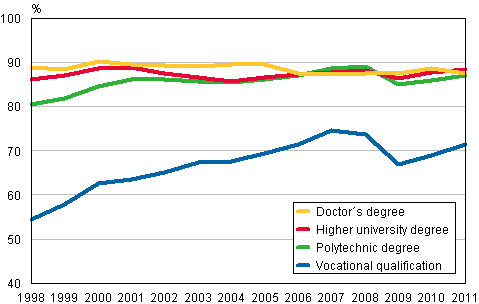Published: 6 March 2013
Most recent graduates found employment more easily than one year before in 2011
According to Statistics Finland, the majority of recent graduates found employment more easily in 2011 than one year earlier. The employment of graduates with upper secondary vocational qualifications improved most, or by good two percentage points. Of them, 71 per cent were employed and 12 per cent were unemployed. Three-quarters of unemployed persons were aged under 30. Employment was found by 87 per cent of those with polytechnic degrees, by 88 per cent of those with higher university degrees, such as master's degrees, similarly by 88 per cent of those with doctor's degrees. Employment of recent graduates has improved or remained unchanged during good ten years despite the weakening of employment in 2009.
Employment of graduates one year after graduation 1998–2011, %

Employment among recent graduates is measured one year after their graduation. Employment among all recent graduates improved by two percentage points from the previous year, 70 per cent were employed. Of all recent graduates, 17 per cent were studying while working and 14 per cent were full-time students; this was so for 38 per cent of the passers of the matriculation examination and for 29 per cent of those with lower university degrees.
The proportion of the unemployed decreased by half a percentage point. The proportion of the unemployed was seven per cent. At 12 per cent, the proportion of the unemployed was the highest among attainers of upper secondary vocational qualifications. Close on six per cent of the graduates from polytechnics and four-and-a-half per cent of the graduates with higher university degrees were unemployed.
Men's and women's transition to working life improved, men's by good three percentage points and women's by nearly two percentage points. However, women found employment more easily than men did. The proportion of employed women was ten percentage points higher than that of men. Of all recent graduates, 64 per cent of men and 74 per cent of women were working. The rate of employment was 66 per cent for men and 77 per cent for women among attainers of upper secondary vocational qualifications. Eighty-six per cent of men and 88 per cent of women with polytechnic degrees were employed. Ninety per cent of men and 87 per cent of women with higher university degrees had found jobs.
There were differences in the transition to working life by field of education. Finding employment was most difficult for those graduating from the field of culture. Their employment rate was 66 per cent. The transition was smoothest for attainers of qualifications in the fields of safety and security, welfare, health and sport. Their employment rate was over 88 per cent. In all fields of education the transition was easier for those with university degrees than for those with upper secondary qualifications. At 18 per cent, the rate of unemployment was highest for those with upper secondary qualifications in the field of natural sciences, vocational qualifications in information and communications technology.
Examined by region, the rate of employment varied from 82 per cent in Åland to 60 per cent in North Karelia. Besides Åland, the rate of employment was higher than the average for the whole country in the regions of Uusimaa, Kanta-Häme and Ostrobothnia.
Source: Education 2013. Statistics Finland
Inquiries: Ritva Kaukonen 09 1734 3311, Anna Loukkola 09 1734 3678, koulutustilastot@stat.fi
Director in charge: Riitta Harala
Publication in pdf-format (236.3 kB)
- Tables
-
Tables in databases
Pick the data you need into tables, view the data as graphs, or download the data for your use.
Appendix tables
- Figures
Updated 6.3.2013
Official Statistics of Finland (OSF):
Transition from school to further education and work [e-publication].
ISSN=1798-9469. 2011. Helsinki: Statistics Finland [referred: 14.12.2025].
Access method: http://stat.fi/til/sijk/2011/sijk_2011_2013-03-06_tie_001_en.html

